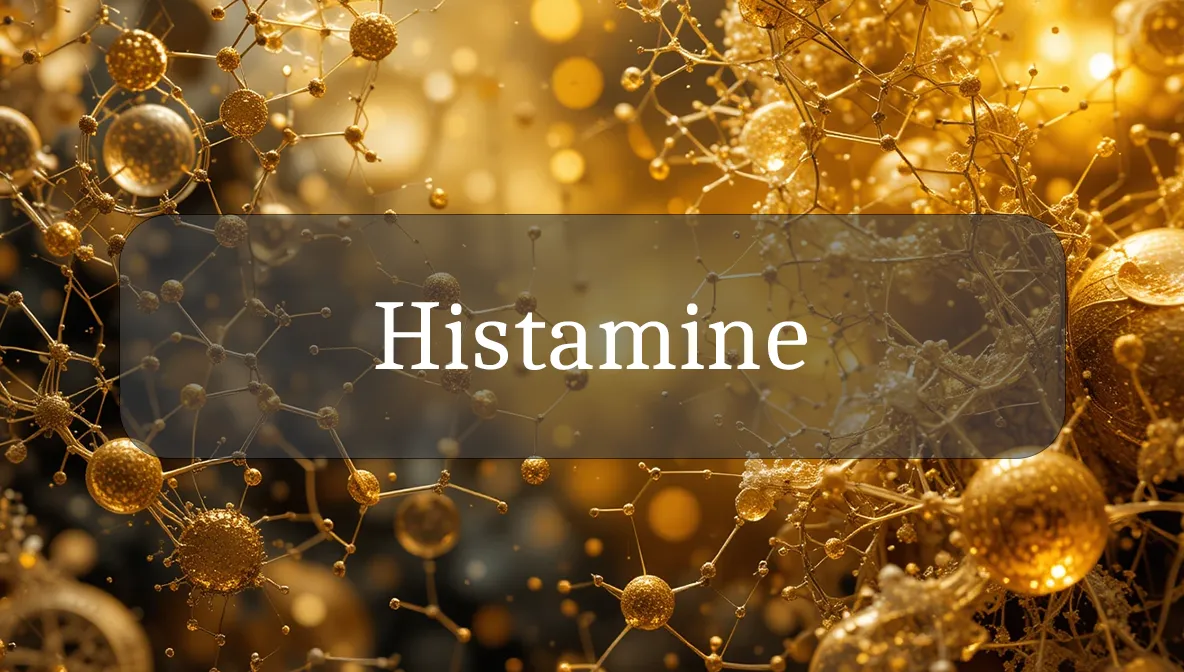Body’s Alert Messenger
Histamine is a small molecule that acts like a rapid-response messenger in your body, triggering immune reactions, regulating digestion, and influencing brain function. While essential for protection, imbalances can cause discomfort or health issues. Let’s explore what histamine is, its role in your wellness, and how to manage it for daily vitality.
Identity and Function
Histamine is a biogenic amine (~111 Da) synthesized from the amino acid histidine by the enzyme histidine decarboxylase. Stored in mast cells, basophils, and enterochromaffin-like cells, it’s released in response to triggers like allergens, injury, or infections. Histamine binds to four receptor types (H1–H4) on cells, mediating effects like inflammation, gastric acid secretion, and neurotransmission. It’s rapidly broken down by enzymes like diamine oxidase (DAO) and histamine N-methyltransferase (HNMT).
Biological Role and Health Impact
Histamine is vital for keeping your body responsive and functional:
- Immune Defense: It triggers inflammation to recruit immune cells to infection or injury sites, aiding pathogen clearance (e.g., bacteria, viruses) and wound healing.
- Allergic Responses: It mediates allergic reactions by causing itching, swelling, or bronchoconstriction, protecting against perceived threats but causing discomfort in allergies (e.g., hay fever).
- Digestion: It stimulates gastric acid secretion in the stomach, aiding protein digestion and nutrient absorption.
- Brain Function: As a neurotransmitter, it regulates wakefulness, appetite, and mood, supporting alertness and cognitive health.
- Blood Vessel Regulation: It dilates blood vessels and increases permeability, delivering immune cells to tissues but potentially causing redness or swelling.
By coordinating immune, digestive, and neurological responses, histamine supports resilience and daily energy.
Production and Sources
Your body produces histamine naturally, with dietary and environmental influences:
- How It’s Produced: Mast cells (in skin, lungs, gut), basophils (in blood), and other cells synthesize and store histamine, releasing it during immune activation, injury, or stress. Levels are regulated by breakdown enzymes (DAO, HNMT).
- Dietary Influence: Histamine-rich foods (e.g., aged cheese, fermented foods, wine) or histidine-rich foods (e.g., fish, meat) can increase levels. Low-histamine diets may help manage imbalances.
- Key Nutrients: Vitamin C (citrus, peppers), zinc (nuts, seeds), and B6 (bananas, chickpeas) support histamine regulation and immune function. Copper (shellfish, seeds) aids DAO activity.
- Environmental Triggers: Allergens (pollen, pet dander), stress, or infections can spike histamine release.
A balanced diet and allergen management support histamine regulation.
Signs of Imbalance
Histamine imbalances, often from overproduction or poor breakdown, can cause health issues:
- Excess Histamine (Histamine Intolerance):
- Symptoms like hives, itching, nasal congestion, headaches, or diarrhea, often after eating histamine-rich foods.
- Flushing, low blood pressure, or asthma-like symptoms in severe cases.
- Caused by low DAO activity (e.g., genetic, nutrient deficiencies, gut issues) or mast cell disorders.
- Allergic Reactions:
- Sneezing, watery eyes, or anaphylaxis (rare) from histamine-driven responses to allergens.
- Chronic Conditions:
- Persistent symptoms in mast cell activation syndrome (MCAS), causing fatigue, rashes, or digestive issues.
- Neurological symptoms like anxiety or insomnia if brain histamine levels are dysregulated.
- Low Histamine (Rare):
- Poor digestion or reduced alertness, though less common and harder to detect.
If you notice persistent allergic symptoms, digestive issues, or unexplained reactions, see a doctor for tests like serum histamine, DAO levels, or allergy panels.
Supporting Healthy Function
To manage histamine levels and maintain balance:
- Follow a Low-Histamine Diet (if needed): Avoid high-histamine foods (e.g., fermented foods, cured meats, alcohol) and choose fresh options (e.g., eggs, fresh vegetables, rice). Consult a dietitian for guidance.
- Support Histamine Breakdown: Include vitamin C (berries, broccoli), B6 (fish, potatoes), and copper (nuts, shellfish) to boost DAO and HNMT activity.
- Manage Allergies: Avoid known triggers (e.g., pollen, dust) and use air purifiers or nasal rinses. Consider antihistamines (e.g., cetirizine) under medical advice.
- Support Gut Health: Eat fiber-rich foods (oats, apples) and probiotics (yogurt, kefir) to improve DAO production in the gut, as dysbiosis can impair histamine clearance.
- Reduce Stress: Chronic stress triggers histamine release, so try meditation, yoga, or deep breathing for 10–15 minutes daily.
Safety and Precautions
Histamine is a natural molecule, but imbalances or conditions require care:
- Medical Conditions: Histamine intolerance, MCAS, or allergies need tailored management. Chronic diseases (e.g., IBS, autoimmune disorders) may amplify symptoms.
- Medications: Antihistamines (H1/H2 blockers) relieve symptoms but may cause drowsiness or interact with other drugs. DAO supplements are available but lack strong evidence; use under medical guidance.
- Nutrient Deficiencies: Low B6, vitamin C, or copper can impair histamine breakdown. Monitor levels with blood tests if symptoms persist.
- Triggers: Alcohol, NSAIDs (e.g., ibuprofen), or certain foods (e.g., tomatoes, spinach) can exacerbate histamine issues. Limit exposure if sensitive.
- Severe Reactions: Anaphylaxis requires immediate epinephrine (EpiPen) and emergency care. Carry medication if you have a history of severe allergies.
If you have persistent symptoms or severe reactions, consult a healthcare provider for tests like tryptase, histamine levels, or food sensitivity panels.
Fun Fact
Did you know histamine keeps you awake? In your brain, it acts like a natural coffee shot, signaling your neurons to stay alert, which is why antihistamines for allergies often make you sleepy!
Citations
- National Institutes of Health (NIH): Histamine and Immune Function.
- Mayo Clinic: Allergies and Histamine Intolerance.
- Cleveland Clinic: Understanding Histamine and Inflammation.
- Journal of Allergy and Clinical Immunology: Histamine in Health (2021).
- Frontiers in Immunology: Histamine Regulation and Disorders (2020).

